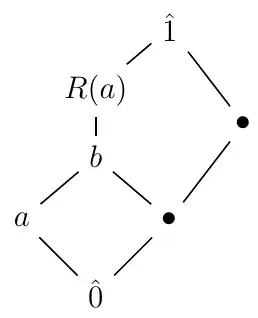Let $L$ be a finite lattice with $\hat{1}$ its maximum and $c_1, \dots, c_n$ its coatoms. Let $E_n=\{1, \dots, n \}$.
For any subset $I \subset E_n$ we define $$C(I) := \bigwedge_{i \in I} c_i$$ then let $$T:=C(E_n)$$ For any $a \in L$ we define $$I(a) := \{i \in E_n \mid a \le c_i \}$$ and $$ R(a) := C(I(a))$$
Let $a \in L \setminus [T,\hat{1}]$ and $b \in [T,\hat{1}]$ such that $a < b$. Then $R(a),b \in [a,R(b)]$, obviously.
Question: Is it true that $R(a) \le b$ if $L$ is modular?
Remark: It is true if $L$ is distributive because then $[T,\hat{1}]$ is boolean, so that $b = R(b)$.
Remark: If we don't assume $L$ modular, then it is false, as for the following lattice with a pentagon: 